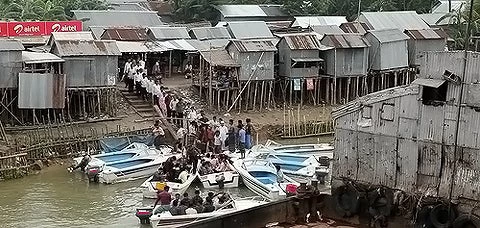For a number of years, a majority of South Asians have been painfully aware that climate change is real and, if left unfettered, has the potential to reverse the significant gains the region has made on poverty reduction and other Millennium Development Goals.
In 2009, the government of the Maldives held a Cabinet meeting underwater to remind the world that the country – which is on average 2.7 meters above sea level – will be completely wiped out if oceans rise.
Nepal’s government held a Cabinet meeting at the base of Mount Everest – at an altitude of 5,242 meters above sea level – to stress that 1.3 billion Asians depend on the seven major rivers with headwaters originating from the vulnerable Himalayan glaciers for their livelihoods.
The Government of Bangladesh has invested over $10 billion in the last decade on disaster risk management and recently established a trust fund for donors to support its climate adaptation program (BBCRF). In the Pew Research Center’s 2010 survey of global attitudes, the Indian public scored second (71%) among G20 countries in favor of supporting higher consumer prices to mitigate climate change, and the Government of India is implementing an innovative market-based mechanism to reduce energy consumption among large emitters.
South Asians feel vulnerable to climate change for a number of reasons.
-Over the past two decades, over 50 percent of South Asians – more than 750 million people – have been affected by natural disasters, with the loss of life estimated at more than 60,000, and damages above $45 billion.
-The Bay of Bengal has been home to eight of the 10 deadliest storms on record, and the region is highly prone to flooding due to its deltaic rivers.
-In 2010, Pakistan’s devastating floods covered one-fifth of the country and displaced 20 million people. This was followed by severe but localized floods in 2011 and 2012.
-In most South Asian countries, around two-thirds of the population is engaged in agriculture for their livelihoods, which is heavily dependent on the monsoon, where 70 percent of rainfall occurs in a four-month period.
-Finally, the region still has more than 600 million poor and 330 million malnourished people who can ill afford to adapt to a changing climate.
-The new World Bank-commissioned report, “Turn Down the Heat: Why a 4°C World Must Be Avoided,” should sound alarm bells across South Asia.
The report’s main premise is that current pledges of greenhouse gas emission reductions place the world on a trajectory for global warming of well over 3 degrees Celsius, with unprecedented consequences for increasing recurrence and intensity of droughts and floods, decreases in agricultural yields, and sea level rise. For Pakistan and Bangladesh, that threatens to turn their fears of flooding to reality, whereas in the Maldives and Bangladesh, there will be increasing concerns regarding sea level rise. For countries with significant agrarian economies and water stress, which includes Pakistan, India and Afghanistan, there should be renewed calls for policy and investment interventions.
The report highlights a number of additional development challenges that have not yet been integrated in public policy in the region – for instance, the acidification of the oceans, the vulnerability of India to sea level rise, and increasing water stress across the region. It also points to important research blind spots that remain for the region, namely with regard to the pace and impact of the melting glaciers of the Himalayas and the potential impact on the South Asian monsoon, which is so important to the region’s agriculture and economies.
Above all, the report will likely renew calls for the integration of equity in global climate policy.
While the region’s greenhouse gas emissions are rising at 3.3% a year – faster than all regions except the Middle East – South Asia’s per capita emissions remain well below the global average, and the region still has hundreds of millions of people who don’t have access to electricity.
For South Asians, climate change is a cruel reminder that its development path will face additional and unprecedented challenges.



Join the Conversation